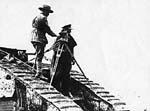1918: Australians in France - The Travelling Exhibition
- 1918: Australians in France
- The Travelling Exhibition
The year 1998 marked the eightieth-year anniversary of the end of the First World War, and one of the most devastating conflicts of this century. In commemorating this event, and focusing on the important contributions of Australian forces in France in 1918, the Australian War Memorial launched a special 1918: Australians In France travelling exhibition. This opened in Canberra on 11 November 1998 - the eightieth anniversary of the armistice that ended the war - and is travelled to a selection of Australian cities and regional centres throughout 1999 - 2001. Exhibition Itinerary
- Curator - Peter Burness
- Assistant curator - Chris Goddard
- Project Manager - Carol Cartwright
- Exhibition designed by Griffiths & Young Design and Ross Owen Feller.
The Relics Collection
The Australian War Records Section Trophy Store at Péronne, 1918, where battle souvenirs were collected for eventual dispatch to Australian war museums.
The amount of spoil captured, both in quantity and variety, is simply beyond description, and the troops have stuffed their pockets with all sorts of interesting souvenirs.
- Letter, Lieutenant General Sir John Monash, 15 August 1918.
In December 1917, General William Birdwood, Australian Corps Commander, sent a circular to all AIF personnel which stated:
The Australian Government has decided to commemorate Australia's share in the present war by the formation, after the war, of Museums, in which will be collections of war trophies, photographs, sketches, trench papers, &c.
The Australian War Records Section (AWRS) was responsible for the collection of these items.

A recaptured tank near Bray, on the Somme. AWMP0520/16/03
There are hundreds of fascinating and unique items held in the Memorial's collections that have never been displayed before. Some highlights of these relics and souvenirs were shown in the 1918: Australians In France exhibition. Some of the displayed items include:
- The control column from the plane crash of the "Red Baron", Manfred von Richthofen
- German, Australian, French, British and American soldiers' uniforms and accessories, some collected by Australian soldiers
- Charred remains of a luminous watch collected from a German aircraft shot down near Hamel
- Two large spanners and a shell case from the Amiens Gun
- Many types of weaponry from 1918, including a model of the Mark V tank
- Several personal stories and histories of Australian men and women who served in 1918
The Photograph Collection

Capt G.H. Wilkins MC, one of the AIF official photographers, recording the Australian advance through the Hindenburg Line. AWME03915
Another particularly interesting aspect of the exhibition were a collection of photographs taken by soldiers themselves in 1918, given that officially, cameras were prohibited among troops during the war. These "diggers' photos" add a unique perspective to those taken by the AIF's official photographers.
Photos by AIF official photographers were also shown, who came under the management of the Australian War Records Section after C.E.W. Bean became aware of the importance of a photographic record of Australia's role in the war, while at Gallipoli.
The Art Collection
To illustrate the events and personalities of 1918, works by key Australian war artists, such as Will and John Longstaff, Arthur Streeton and James Scott were shown in this exhibition.
Lt James P. Quinn, an Australian Official War Artist at work in Mont St Quentin, 7 September, 1918.
Dawn at Hamel, 4 July 1918 by George Bell, one of the Australian official war artists.



